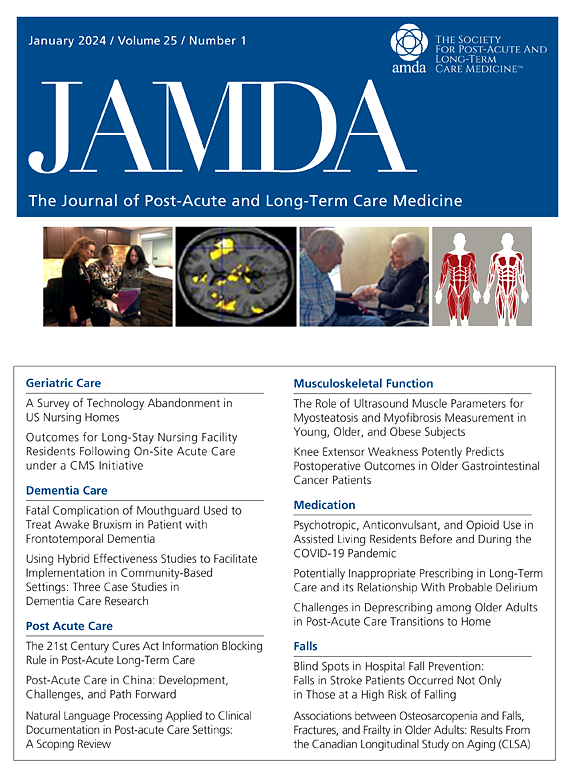Usage and Costs of Regular Acetaminophen (Paracetamol) in Canadian Long-Term Care Facilities
IF 3.8
2区 医学
Q2 GERIATRICS & GERONTOLOGY
Journal of the American Medical Directors Association
Pub Date : 2025-07-10
DOI:10.1016/j.jamda.2025.105722
引用次数: 0
Abstract
Objectives
Evidence suggests that the use of regular acetaminophen (paracetamol) in long-term care (LTC) is a low-value intervention, that it does not improve pain or quality of life, and that it has the potential for adverse effects. Our objective was to assess the usage of regular acetaminophen in Canadian LTC facilities as well as the costs associated with its use.
Design
Cross-sectional study.
Setting and Participants
Canadian LTC facilities serviced by a national LTC pharmacy provider in 2022.
Methods
Descriptive statistics were used to characterize prevalence, dosing, dispensation frequency, type, and costs of regular acetaminophen dispensations (cost of tablets, carbon emissions, and nursing dispensation time).
Results
The data set included 49,419 residents (median age: 86, women: 65%) from British Columbia (5.5%), Alberta (7.1%), Manitoba (23.0%), and Ontario (64.4%). The mean prevalence of regular acetaminophen dispensations was 45.7%. Among residents dispensed regular acetaminophen, 85% of residents were dispensed >1000 mg of acetaminophen/day, the mean defined daily dose per 1000 residents per 1 day was 317 [standard deviation (SD) 56], 59.3% were dispensed acetaminophen ≥3 times per day, and dispensations were approximately evenly split between 325- and 500-mg tablets. The 27.8 million tablets of acetaminophen dispensed in 2022 cost $870,000; had a carbon footprint of 54.8 tonnes of carbon dioxide equivalents (CO2e); and required 191,000 nursing hours, the equivalent of 92 nurses working full-time for 1 year.
Conclusion and Implications
Regular acetaminophen use is highly prevalent in LTC and has substantial costs. It would be advantageous to re-examine acetaminophen use in LTC facilities.
加拿大长期护理机构常规扑热息痛(扑热息痛)的使用和费用
目的:有证据表明,在长期护理(LTC)中使用常规对乙酰氨基酚(扑热息痛)是一种低价值的干预措施,它不能改善疼痛或生活质量,而且有潜在的不良反应。我们的目的是评估加拿大LTC设施中常规对乙酰氨基酚的使用情况以及与使用相关的成本。设计:横断面研究。环境和参与者:2022年加拿大LTC设施由国家LTC药房提供商提供服务。方法:采用描述性统计方法对常规扑热息痛处方的流行程度、剂量、配药频率、剂型和成本(片剂成本、碳排放和护理配药时间)进行分析。结果:数据集包括来自不列颠哥伦比亚省(5.5%)、阿尔伯塔省(7.1%)、马尼托巴省(23.0%)和安大略省(64.4%)的49,419名居民(中位年龄:86岁,女性:65%)。对乙酰氨基酚常规配药的平均患病率为45.7%。在常规使用对乙酰氨基酚的居民中,85%的居民每天使用对乙酰氨基酚1000mg /天,每1000名居民每1天的平均定义日剂量为317(标准差[SD] 56), 59.3%的居民每天使用对乙酰氨基酚≥3次,配药剂量大致平均分配在325 mg和500 mg片之间。2022年发放的2780万片对乙酰氨基酚花费87万美元;碳足迹为54.8吨二氧化碳当量(CO2e);需要19.1万护理小时,相当于92名护士全职工作1年。结论和意义:定期使用对乙酰氨基酚在LTC中非常普遍,并且有很大的成本。重新审视对乙酰氨基酚在LTC设施中的使用是有益的。
本文章由计算机程序翻译,如有差异,请以英文原文为准。
求助全文
约1分钟内获得全文
求助全文
来源期刊
CiteScore
11.10
自引率
6.60%
发文量
472
审稿时长
44 days
期刊介绍:
JAMDA, the official journal of AMDA - The Society for Post-Acute and Long-Term Care Medicine, is a leading peer-reviewed publication that offers practical information and research geared towards healthcare professionals in the post-acute and long-term care fields. It is also a valuable resource for policy-makers, organizational leaders, educators, and advocates.
The journal provides essential information for various healthcare professionals such as medical directors, attending physicians, nurses, consultant pharmacists, geriatric psychiatrists, nurse practitioners, physician assistants, physical and occupational therapists, social workers, and others involved in providing, overseeing, and promoting quality

 求助内容:
求助内容: 应助结果提醒方式:
应助结果提醒方式:


